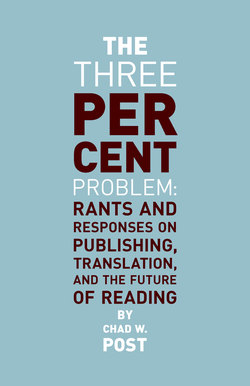Читать книгу The Three Percent Problem - Chad W. Post - Страница 8
На сайте Литреса книга снята с продажи.
Sales of
Translations
ОглавлениеRachel Deahl’s 2008 article for Publishers Weekly on how well translations sell is really interesting (not just because we’re mentioned there) and worth expanding a bit.
The main idea comes from Tom Colchie, famous translator and literary agent (and all around nice guy), who thinks that the “doom and gloom about readers avoiding works in translation is off the mark”:
Colchie also believes that given the dearth of translations published in the U.S., their hit ratio is similar to, or better than, English-language titles. “If you take the performance of the 200 to 300 translations published a year and compare them to the performance of the 200,000-plus [American] titles published, you won’t see a big difference.”
(One of the first things that jumps out to me about this is that if his numbers are accurate, then even Eliot Weinberger’s belief that only 0.3% of books published in the U.S. are in translation is overblown. According to this, the figure is closer to 0.1%.)
Echoing my comment in the article, this seems to be a statistical game of sorts. Since there are so few translations published, a higher percentage of them “take off” compared to the percentage of American authors that become household names. (In other words, if 25 of 300 literary translations do well, that’s a much better percentage than the 500 or so American books out of the 40,000+ published annually that do really well.)
It’s an interesting argument to make, especially taken in combination with Colchie’s later statement—”I now sell fewer books in a year, but sell them for a lot more money.”
This comes as no surprise, but what he seems to be describing is a publishing industry more bottom-line conscious than ever. I believe that publishers are willing to shell out more cash for books from wherever that are capable of selling hundreds of thousands of copies. Instead of being a translation vs. English question, perhaps this experience is representative of how publishing functions in a marketplace where (thanks to chains, WalMart, etc.) at any point in time, twelve to twenty books are selling spectacularly well and are everywhere (a la Shadow of the Wind or The Da Vinci Code) while most everything else is puttering along.
I’m not sure exactly what to make of this. One the one hand, the more books published in translation, the better; on the other hand, Colchie’s saying that the sheer number of translated books is declining but that the number of best-selling titles that get translated is increasing. Which, as someone who doesn’t usually read best sellers, doesn’t appeal to me all that much.
Another interesting aspect of this article are the Nielsen numbers at the bottom. Nielsen numbers aren’t precise, and the arguments against this are well documented, but for the basis of comparison, it’s pretty illuminating. Of the four books cited, The Savage Detectives is the most clearly “literary” (in my elitist opinion) and sold 22,000 copies—a figure that is spectacular in terms of literary fiction, and demonstrates how much publicity and good attention Bolaño has been receiving—but that is still 55,000 copies lower than the next book on the list, Perez-Reverte’s The Queen of the South, which has sold 77,000 copies since 2004, and it’s dwarfed by Serra’s The Secret Supper’s 88,000 copies and The Shadow of the Wind’s 518,000.
